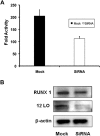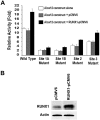RUNX1/core binding factor A2 regulates platelet 12-lipoxygenase gene (ALOX12): studies in human RUNX1 haplodeficiency
- PMID: 20181616
- PMCID: PMC2858475
- DOI: 10.1182/blood-2009-04-214601
RUNX1/core binding factor A2 regulates platelet 12-lipoxygenase gene (ALOX12): studies in human RUNX1 haplodeficiency
Abstract
Haploinsufficiency of RUNX1 (also known as CBFA2/AML1) is associated with familial thrombocytopenia, platelet dysfunction, and predisposition to acute leukemia. We have reported on a patient with thrombocytopenia and impaired agonist-induced aggregation, secretion, and protein phosphorylation associated with a RUNX1 mutation. Expression profiling of platelets revealed approximately 5-fold decreased expression of 12-lipoxygenase (12-LO, gene ALOX12), which catalyzes 12-hydroxyeicosatetraenoic acid production from arachidonic acid. We hypothesized that ALOX12 is a direct transcriptional target gene of RUNX1. In present studies, agonist-induced platelet 12-HETE production was decreased in the patient. Four RUNX1 consensus sites were identified in the 2-kb promoter region of ALOX12 (at -1498, -1491, -708, -526 from ATG). In luciferase reporter studies in human erythroleukemia cells, mutation of each site decreased activity; overexpression of RUNX1 up-regulated promoter activity, which was abolished by mutation of RUNX1 sites. Gel shift studies, including with recombinant protein, revealed RUNX1 binding to each site. Chromatin immunoprecipitation revealed in vivo RUNX1 binding in the region of interest. siRNA knockdown of RUNX1 decreased RUNX1 and 12-LO proteins. ALOX12 is a direct transcriptional target of RUNX1. Our studies provide further proof of principle that platelet expression profiling can elucidate novel alterations in platelets with inherited dysfunction.
Figures




 , supershift); lane 5, effect of nonspecific IgG; lane 6, free probe with site 3; lane 7, protein binding with recombinant RUNX1; lanes 8, competition with excess unlabeled probe; lane 9, effect of RUNX1 antibody (
, supershift); lane 5, effect of nonspecific IgG; lane 6, free probe with site 3; lane 7, protein binding with recombinant RUNX1; lanes 8, competition with excess unlabeled probe; lane 9, effect of RUNX1 antibody ( , supershift): and lane 10, effect of nonspecific IgG.
, supershift): and lane 10, effect of nonspecific IgG.


 ), or neither (□), along with ALOX12 luciferase-reporter construct (−1593/−1), wild-type, or with mutations in sites 1A, 1B, 2, or 3. Reporter activity was measured at 48 hours. Bar graphs represent activity as mean ± SD of 3 experiments. (B) Western blotting analysis of RUNX1 and actin (control) in HEL cells transfected with pCMV6 vector alone or with RUNX1-pCMV6 vector.
), or neither (□), along with ALOX12 luciferase-reporter construct (−1593/−1), wild-type, or with mutations in sites 1A, 1B, 2, or 3. Reporter activity was measured at 48 hours. Bar graphs represent activity as mean ± SD of 3 experiments. (B) Western blotting analysis of RUNX1 and actin (control) in HEL cells transfected with pCMV6 vector alone or with RUNX1-pCMV6 vector.Similar articles
-
Dysregulation of PLDN (pallidin) is a mechanism for platelet dense granule deficiency in RUNX1 haplodeficiency.J Thromb Haemost. 2017 Apr;15(4):792-801. doi: 10.1111/jth.13619. Epub 2017 Feb 23. J Thromb Haemost. 2017. PMID: 28075530 Free PMC article.
-
Regulation of platelet myosin light chain (MYL9) by RUNX1: implications for thrombocytopenia and platelet dysfunction in RUNX1 haplodeficiency.Blood. 2010 Dec 23;116(26):6037-45. doi: 10.1182/blood-2010-06-289850. Epub 2010 Sep 27. Blood. 2010. PMID: 20876458 Free PMC article.
-
Defective RAB1B-related megakaryocytic ER-to-Golgi transport in RUNX1 haplodeficiency: impact on von Willebrand factor.Blood Adv. 2018 Apr 10;2(7):797-806. doi: 10.1182/bloodadvances.2017014274. Blood Adv. 2018. PMID: 29632235 Free PMC article.
-
Biology and pharmacology of platelet-type 12-lipoxygenase in platelets, cancer cells, and their crosstalk.Biochem Pharmacol. 2022 Nov;205:115252. doi: 10.1016/j.bcp.2022.115252. Epub 2022 Sep 18. Biochem Pharmacol. 2022. PMID: 36130648 Review.
-
Familial mutations of the transcription factor RUNX1 (AML1, CBFA2) predispose to acute myeloid leukemia.Leuk Lymphoma. 2004 Jan;45(1):1-10. doi: 10.1080/1042819031000139611. Leuk Lymphoma. 2004. PMID: 15061191 Review.
Cited by
-
A role for RUNX1 in hematopoiesis and myeloid leukemia.Int J Hematol. 2013 Jun;97(6):726-34. doi: 10.1007/s12185-013-1347-3. Epub 2013 Apr 24. Int J Hematol. 2013. PMID: 23613270 Review.
-
Bleeding risks for uncharacterized platelet function disorders.Res Pract Thromb Haemost. 2020 May 30;4(5):799-806. doi: 10.1002/rth2.12374. eCollection 2020 Jul. Res Pract Thromb Haemost. 2020. PMID: 32685888 Free PMC article.
-
Development of a Bioinformatics Framework for Identification and Validation of Genomic Biomarkers and Key Immunopathology Processes and Controllers in Infectious and Non-infectious Severe Inflammatory Response Syndrome.Front Immunol. 2020 Mar 31;11:380. doi: 10.3389/fimmu.2020.00380. eCollection 2020. Front Immunol. 2020. PMID: 32318053 Free PMC article.
-
An Updated Overview of the Role of CYP450 during Xenobiotic Metabolization in Regulating the Acute Myeloid Leukemia Microenvironment.Int J Mol Sci. 2023 Mar 23;24(7):6031. doi: 10.3390/ijms24076031. Int J Mol Sci. 2023. PMID: 37047003 Free PMC article. Review.
-
Inherited platelet dysfunction and hematopoietic transcription factor mutations.Platelets. 2017 Jan;28(1):20-26. doi: 10.1080/09537104.2016.1203400. Epub 2016 Jul 27. Platelets. 2017. PMID: 27463948 Free PMC article. Review.
References
-
- Mikhail FM, Sinha KK, Saunthararajah Y, Nucifora G. Normal and transforming functions of RUNX1: a perspective. J Cell Physiol. 2006;207(3):582–593. - PubMed
-
- Okuda T, van Deursen J, Hiebert SW, Grosveld G, Downing JR. AML1, the target of multiple chromosomal translocations in human leukemia, is essential for normal fetal liver hematopoiesis. Cell. 1996;84(2):321–330. - PubMed
-
- Ichikawa M, Asai T, Chiba S, Kurokawa M, Ogawa S. Runx1/AML-1 ranks as a master regulator of adult hematopoiesis. Cell Cycle. 2004;3(6):722–724. - PubMed
-
- Song WJ, Sullivan MG, Legare RD, et al. Haploinsufficiency of CBFA2 causes familial thrombocytopenia with propensity to develop acute myelogenous leukaemia. Nat Genet. 1999;23(2):166–175. - PubMed
Publication types
MeSH terms
Substances
Grants and funding
LinkOut - more resources
Full Text Sources

